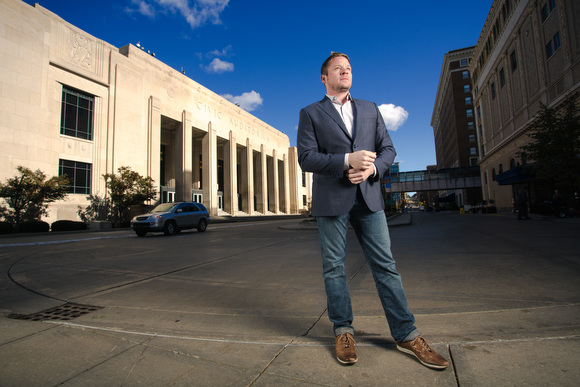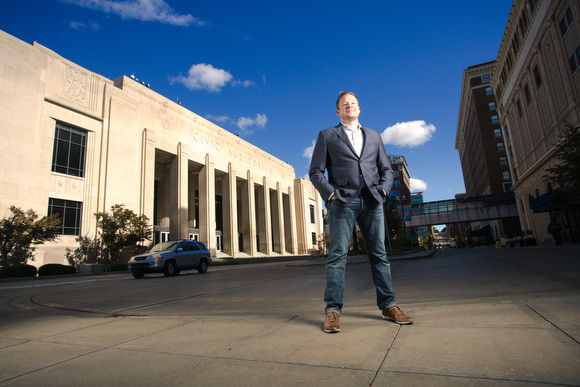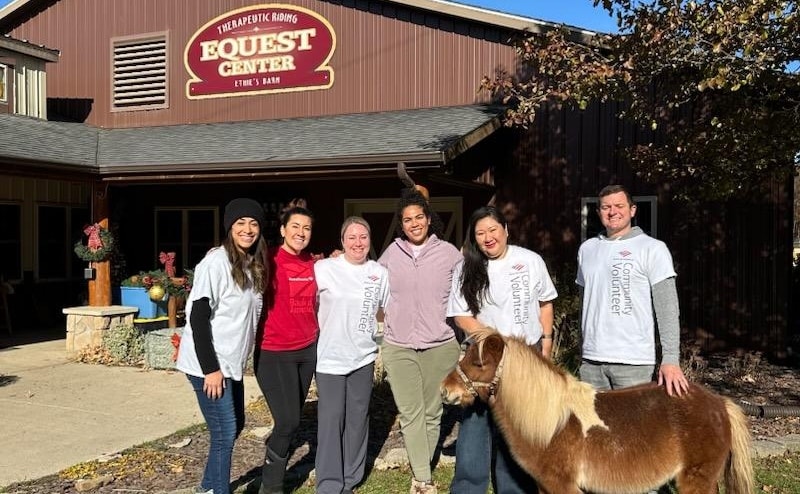Grand Rapids at a Tipping Point
Grand Rapids' Downtown Development Authority is changing in many ways, from its name to its face. Executive Director Kristopher Larsen shares a few of his ideas and the organization's vision for the future.
Kristopher Larson, the relatively new executive director of the Downtown Development Authority (DDA), comes to Grand Rapids from Long Beach, CA where he acted as VP of the Downtown Long Beach Association. Before that, Larson lived in Raleigh, NC. So, it’s suffice to say, we’re zeroing in on Larson’s first Michigan winter.
Larson says he was born and raised in Raleigh and was there for a “very fun part” of the city’s transformation. “When I was a kid,” he says, “[Raleigh] had a population similar to Grand Rapids — about 180,000. When I left, it was 400,000. We had all these tremendous opportunities, and helping to direct a lot of that was a fun time. But, eventually, I just wanted to stretch my legs.”
Larson moved to California at the beginning of the recession and stayed there for four years. Los Angeles was intriguing to him. “You have the archetypal view communicated via media, and then you get there, and it’s something quite different,” he says. “It’s a city of many different types of experiences.”
And then there’s Grand Rapids. A different climate, a smaller size, a different culture. Why come here? “The biggest thing,” Larson says, “would be the opportunity. [Grand Rapids] is at that tipping point where a lot of things are coming together, and it’s not downhill from here. There’s certainly a swelling of local support coming from many directions, and I think that’s going to help usher in a new wave of enthusiasm.”
One of Grand Rapids’ biggest assets, Larson feels, and perhaps an underestimated one, is civic pride. “[Civic pride] can be such a brilliant advantage in community building,” he says. Grand Rapids also, he says, has had positive downtown stewardship in recent years, which has helped the area to grow. He points to the Heartside, and the impact investments like the Van Andel Arena and surrounding properties have made on the neighborhood. This, when combined with the effort to provide affordable housing and to help people to remain in place, has provided in some of the benefits of gentrification “without the externalities.”
When asked why he feels he was selected for his new position, he says his guess is that the DDA was looking for “new ideas — not time-tested ideas, but new ideas and a new style.”
The new style will come with a big change. This summer, it was announced that the DDA will merge with two other organizations, The Downtown Improvement District and the Downtown Alliance, to become Downtown GR, Inc. The new model aims to promote collaboration among the three entities, and Larson will serve as the chief executive officer.
“The idea of the DDA is that you can’t approach it from the understanding of it being an instrument of the implementation. The idea of the Downtown GR, Inc. model is more of a leadership and planning model with an implementation arm. With the change of the organization, [the DDA] is looking for a change in style.” Recently, in a Rapid Growth Not Your Average Speaker Series on placemaking, Larson demonstrated the energy and change of style that he brings to the community. We had underestimated the amount of people who would arrive to the speaking event — we didn’t have enough chairs, and we had to run out for more wine. But Larson effortlessly spoke to a half-standing crowd on his ideas for the city with a freshness and effortlessness that engaged the room.
And when it comes to ideas, Larson has plenty. Some are obvious, like opportunities involving the river Grand Rapids is named after. “It’s not about what happens between the banks; it’s about the focus of the community on that resource,” he says. “It’s the most significant resource we have. It’s the one thing that will be here 100 years from now.” In the interview process when Larson was bidding for the job, he had suggested a transparent walkway over the river. He’s been photographed standing in it.
Another idea is less obvious, until you look at a map of the downtown area, and he points to all the surface parking lots. “From a landuse perspective,” he says, “they are by far the least efficient.” Many of the lots are owned by the DDA, acquired via landbanking. Many of the buildings Grand Rapids acquired through landbanking have been renovated, meaning the opportunity for rehab projects are running out.
“The community is going to transition to a new development cycle that will take the form of new construction,” Larson says, “and [surface lots] are great development sites. We need to think about a thoughtful method of land disposition downtown. They shouldn’t be surface parking lots, but rather the future pieces of the puzzle — something that contributes to the community, more than a place to store cars. You don’t build cities around cars. You build cities around people.”
So where do you put the cars? In the best case scenario, he says, parking is “forgettable.” If the destination and experience are desirable enough, Larson says, parking becomes an afterthought. “People don’t go to places because it’s easy to park there.” The real challenge is overcoming barriers and incentivizing a community to make difference choices.
One such incentive is providing convenient, affordable public transit. December 10 will see the commence of service from DASH North, a pilot transit service powered by The Rapid connecting the Monroe North neighborhood with the Medical Mile and downtown. DASH North will be free to use and arrive every 20 minutes. Funded by the DDA, GR Parking Services, and the Monroe North Tax Increment Finance Authority (MNTIFA), the program has funding to run for two years. In a press release, Larson is quoted as saying, “Building a central city that’s easy to get around and connected to adjacent neighborhoods is one of the community’s top priorities.”
In addition to Larson’s goal of expanded connectivity, he also mentions policy.
“There’s an opportunity to expand upon the street infrastructure,” he says. “I’ll generally call out this private use of public space, and do more to encourage the outdoor utilization of our streetscapes in non-contained ways — the blending within the public realm of public utility versus private interest, and trying to blur those edges. That’s more of a policy thing.”
Sure, but what does it mean? “I don’t believe that because you have a glass of wine in your hand that you should have to sit behind a fence,” he says, more frankly. “People are inherently smart and understand social contracts, and you don’t need an explicit definition or line. I believe that we trade a tremendous amount of the public realm when we require those types of things, like fences. When that business closes for the day, that fence doesn’t go away, but we did just give away 10 feet of sidewalk for bike riders or dog walkers.”
While a matter of months out, Downtown Grand Rapids, Inc. would ideally find home in an accessible, welcoming, easy to find space where the public would find a wealth of information and opportunities for involvement. Larson hopes Grand Rapidians will take the opportunity to become a part of forming the community and be inclined to visit often.
“When we talk about [Downtown GR, Inc.], it’s really about that transfer of leadership to the community at large,” Larson says. “I would say from a biggest picture perspective, what I intend to change is who holds the mic. I don’t intend to lead this organization from any sort of bully pulpit, but I intend to engage the community in really developing a vision for its downtown. It’s really harnessing that energy and love of the community, and directing it. If you care about this community, I want to give you the opportunity to change or improve it.”
J. Bennett Rylah is the Managing Editor of Rapid Growth Media.
Photographs by Adam Bird
















